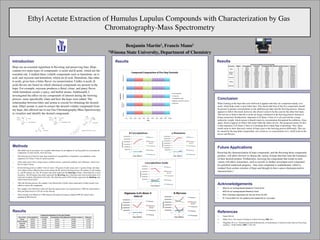
ACS Poster
- 1. Ethyl Acetate Extraction of Humulus Lupulus Compounds with Characterization by Gas Chromatography-Mass Spectrometry Benjamin Martin1, Francis Mann1 1Winona State University, Department of Chemistry Introduction Hops are an essential ingredient in flavoring and preserving beer. Hops contain two main types of compounds: α-acids and β-acids, which are the essential oils. I studied these volatile compounds such as humulone, an α- acid, and myrcene and humulene, which are β-acid. Humulone, like other α-acids, gives beer a bitter flavor via isomerization. Unlike α-acids, β- acids flavors are based on which chemical compounds are present in the hops. For example, myrcene produces a floral, citrus, and piney flavor, while humulene creates a spicy, and herbal aroma. Additionally I investigated the effect on my compounds of interest during the brewing process, more specifically when and how the hops were added. The relationship between bitter and aroma is crucial for obtaining the desired taste. Ethyl acetate is used to extract the desired volatile compounds from my hops; this allowed me to use Gas Chromatography-Mass Spectroscopy to visualize and identify the desired compounds. Conclusion When looking at the hops that were followed it appears that they are comprised mainly of α- acids, which help create a more bitter beer. This means that four of the five compounds should be present in greater concentrations as the additions get later into the brewing process. Simcoe appears to follow this trend, however, this doesn’t seem to be the case for the other four hops. This led me to believe that the α-acids are being volatilized in the brewing process instead of being isomerized. Furthermore, stigmasta-4,22-diene-3-beta-ol is a β-acid and has a large molecular weight, which means it should retain its concentration throughout the additions. Once again, Simcoe appears to follow this trend while the others do not. The proposed reason for this is that stigmasta-4,22-diene-3-beta-ol is breaking down rather than evaporating. Thus, these trends seem to show that each variety of hops react to the brewing process differently. This can be caused by the hop plant composition, size of leaves, or concentration of α- and β-acids in the leaves and flowers. Results Methods • The initial step in my project was to gather information on all eighteen of my hop plants by extracting the compounds, in ethyl acetate, from dry hops. • This allowed me to find five hops that contained β-caryophyllene, α-humulene, caryophyllene oxide, stigmasta-4,22-diene-3-beta-ol, and β-myrcene. • I then made micro-brews using simcoe, northern brewer, centennial, golding, and willamette, which were the five hops I chose. • In this brewing process I added 1 liter of water, 120 grams of malt syrup, and 1.5 grams of hops. the hops were added at three different time points during the 90 minute brewing process (30 minutes in, 60 minutes in , and 80 minutes in). The 30 minutes time point represents the bittering of hops, which help the α-acids isomerize. The 60 minute time point represents the flavoring step, which prevents total isomerization of α- acids and complete elimination of β-acids. The final time point at 80 minutes represents the finishing step, which retains the β-acids.2 • After the brewing process, the samples were filtered into a bottle where equal parts of ethyl acetate were added to extract the compounds. • The samples were allowed to settle and then the organic layer was separated into a 500-mL round bottom flask and dried down to 4.56 mL on the rotovap. • These sample were diluted to 1/100 solution and analyzed using an Agilent 6890 GC paired with a quadrupole MS detector. Future Applications Knowing the characterization of hops compounds, and the flavoring those compounds produce, will allow brewers to choose the variety of hops that best suits the formation of their desired product. Furthermore, knowing the compounds that reside in each variety will allow researchers, such as myself, to further investigate each compound for potential medicinal purposes. One such compound is xanthohumol, which is isolated from certain varieties of hops and thought to have cancer chemopreventive characteristics.3 Acknowledgements • WSU for an Undergraduate Research Travel Grant • WSU for an Undergraduate Research Grant • WSU Chemistry Department for the use of the GC-MS • Dr. Francis Mann for her guidance and leadership on my project References 1. Sigma Aldrich 2. Miller, Dave. The complete Handbook of Home Brewing 1988, 201. 3. Magalhães PJ; et al. “Fundamentals and Health Benefits of Xanthohumol, A Natural Product Derived From Hops and Beer”. NCBI PubMed 2009, 4, 591-610. Results Results β-caryophyllene1 Caryophyllene oxide1 α-humulene1 β-myrcene1 Stigmasta-4,22-diene-3-beta-ol
